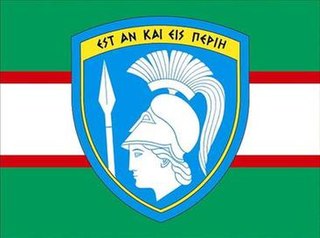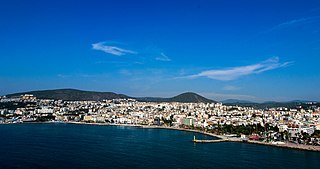
The Hellenic Army, formed in 1828, is the land force of Greece. Along with the Hellenic Air Force (HAF) and the Hellenic Navy (HN), it makes up the Hellenic Armed Forces. It is currently the largest branch of the three. The army is headed by the chief of the Hellenic Army General Staff (HAGS), which in turn is under the command of Hellenic National Defence General Staff (HNDGS).
Hellenic Army is commanded by the Hellenic Army General Staff which supervises five major commands. These are:

The I Army Corps was an army corps of the Hellenic Army, founded in December 1913. Originally based in Athens and covering southern Greece, since 1962 it was responsible for covering Greece's northwestern borders. It was disbanded in 2013.

The IV Army Corps is an army corps of the Hellenic Army. Established before the First World War, it served in all conflicts Greece participated in until the German invasion of Greece in 1941. Re-established in 1976, it has been guarding the Greco-Turkish land border along the Evros River, and is the most powerful formation in the Hellenic Army.

The 2nd Mechanized Infantry Division is a division of the Hellenic Army.

Leonidas Paraskevopoulos was a senior Greek military officer and politician. He played a major role in Greece's war effort during World War I, and was the commander-in-chief of the Greek Army of Asia Minor in 1919–20. In later life he was a member of the Greek Senate and served as its speaker in 1930–32.

The 32nd Marines Brigade, 32 TAX PN - 32 Taxiarhia Pezonavton "Moravas", is the marine unit of Greece. The brigade is based at the port town of Volos in Thessaly, and its primary role is infantry and amphibious operations on the numerous islands off the Greek coast. Unlike other countries, the Greek Marines form part of the Army, while the landing craft and naval equipment are provided by the Hellenic Navy.

The 24th Infantry Division Pinerolo was an infantry division of the Italian Army during World War II.

The 1st Raider/Paratrooper Brigade, is a brigade-sized formation of elite Greek light infantry and special operations forces. The formation is more commonly referred to as the Raider Forces, and a soldier belonging to the Brigade a Raider.

The 1st Infantry Division "Smyrni" is an historic and elite division of the Hellenic Army. It was founded in 1897 as an infantry division and has fought in all major conflicts in which Greece has been involved. During the Balkan Wars, it acquired the sobriquet "Iron Division".
Ancient Macedonia employed a range of tactics and formations in their military campaigns, the most notable of these is the Macedonian phalanx, Developed by Philip II and used extensively on campaign by his son Alexander the Great.
The Battle of Mouzaki occurred on 4 May 1878 between Greek irregulars with the cover support of the Greek Army against the Ottoman forces.
The following is the order of battle of the Hellenic Army during the First Balkan War.
The Army of Thessaly was a field army of Greece, activated in Thessaly during the Greco-Turkish War of 1897 and the First Balkan War in 1912, both times against the Ottoman Empire and commanded by Crown Prince Constantine.
The 3rd Infantry Division was an infantry division of the Hellenic Army.
The 1st Infantry Regiment is a motorized infantry regiment of the Hellenic Army. Established in 1885 at Athens, it fought in all conflicts in which Greece participated until World War II, when it was disbanded following the German invasion of Greece. It was re-established as the 21st Brigade in 1945, and participated in the Greek Civil War. Receiving the designation 1st Infantry Regiment again in 1951, it was headquartered in Florina from 1952 until its disbandment in 1998. In 2013 it was re-established at Florina.
The 19th Mechanized Division was a mechanized infantry division of the Hellenic Army, established on 15 January 1941. Its formation was not completed until late March. Its nucleus was the pre-war Mechanized Cavalry Regiment, augmented with captured Italian tankettes and cars, motorcycles and Universal Carriers provided by the British. Although officially a "mechanized" unit, as the division was mostly truck-borne, it is usually called the 19th Motorized Division in English-language literature.

The 4th Infantry Brigade was an infantry brigade of the Hellenic Army. Originally formed in 1897, it served until 1912. Re-formed in the lead-up to the Greco-Italian War in 1940, it was expanded and renamed as the 15th Infantry Division after the war started. It was again reactivated in 1998, and served until 2013.
Solon Gikas was a Greek Army officer who rose to the rank of Lieutenant General and held the post of Chief of the Hellenic Army General Staff in 1954–1956. He also served as Minister for Communications and Public Works in 1958–63 and Minister for Public Order in 1974–76 under Konstantinos Karamanlis.
















